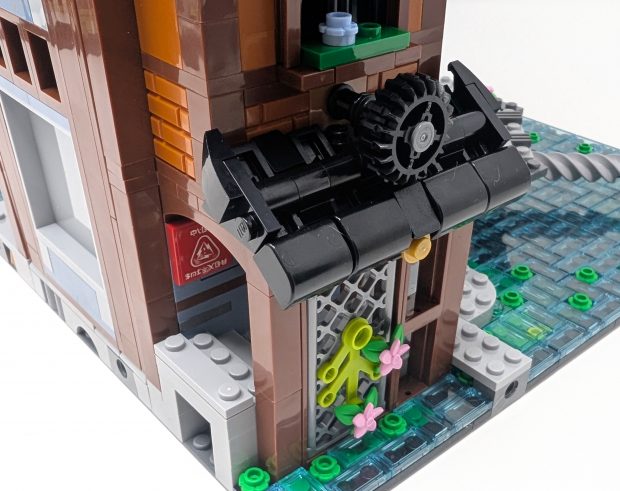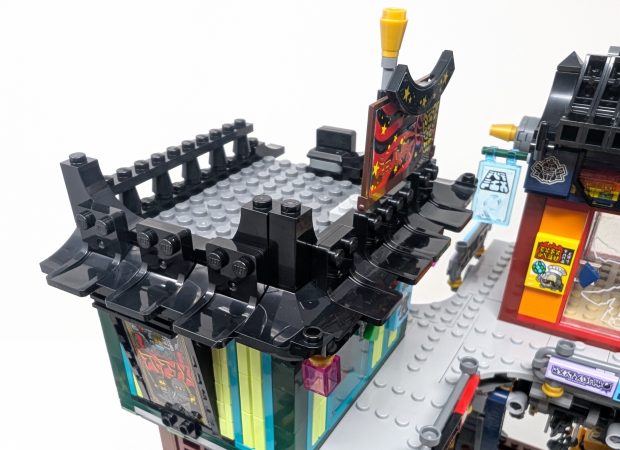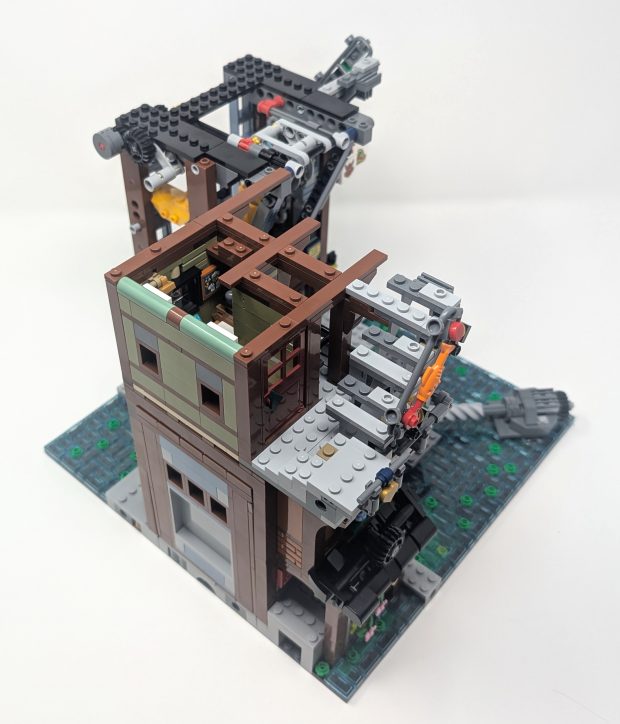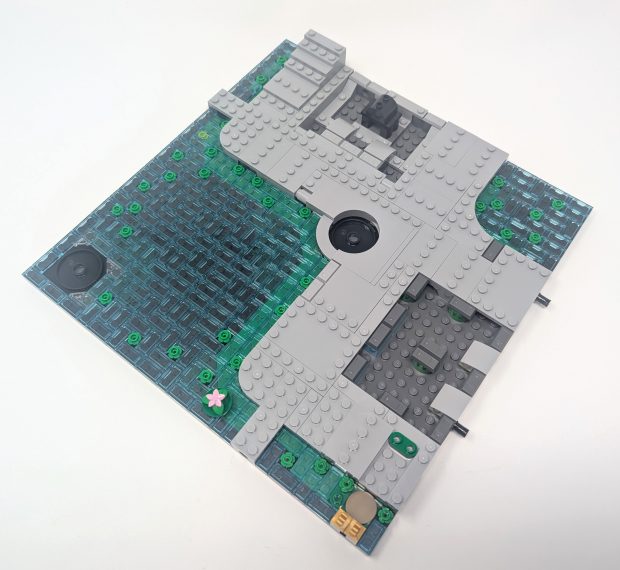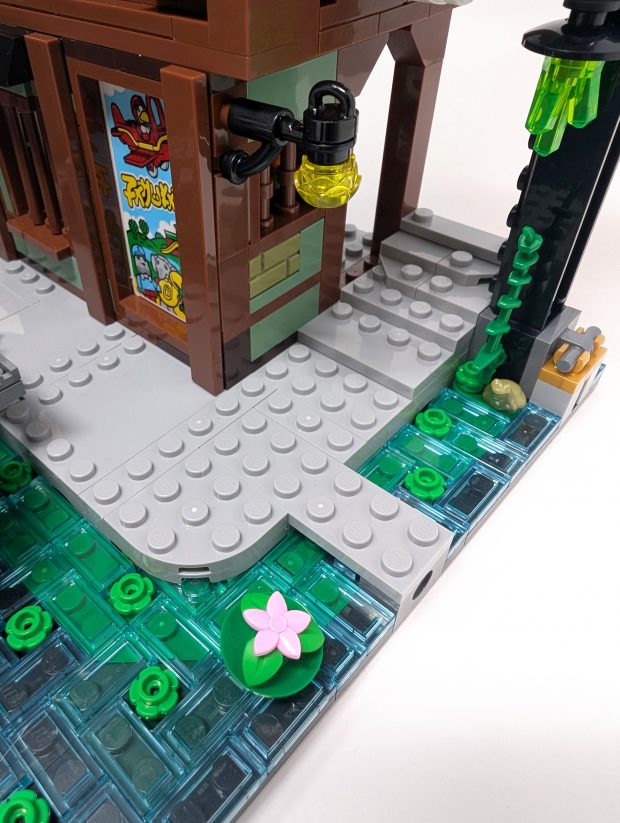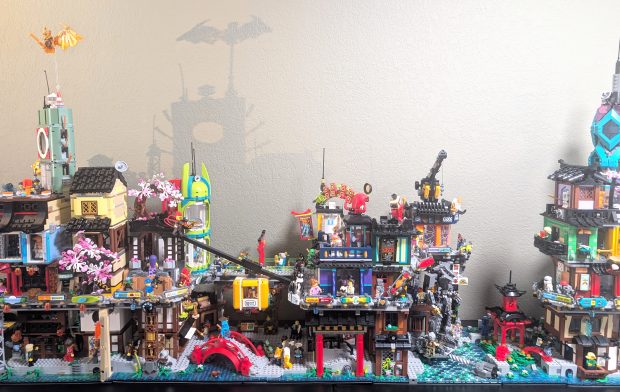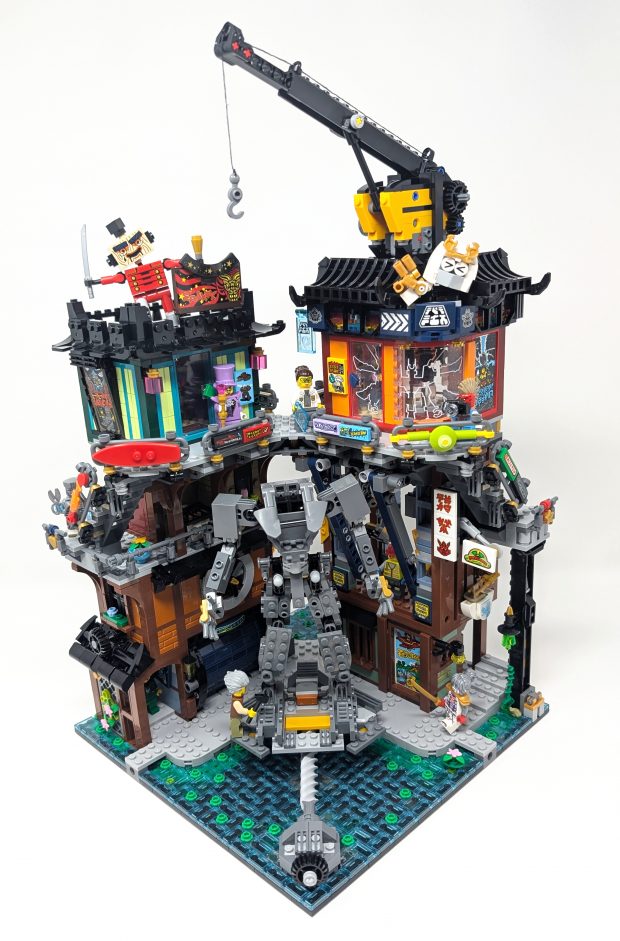#71837 Ninjago City Workshops — What defines the series’ unique style?
Exploring how strong visual storytelling, a layered architecture style, and eclectic motifs converge to create a brick-build world that is chaotic but deeply intentional.
71837: Ninjago City Workshops feels alive from the moment you start building. The set follows in footsteps of earlier sets from this series with elevated walkways, bustling storefronts, and simulated refractive light through stacked tiles that mimic depth. This set is a dynamic vertical slice of urban life in Ninjago City, layered with personality and purpose.
71837: Ninjago City Workshops is the latest installment in the iconic cityscape series, boasting 3,244 pieces, 10 minifigures, and a retail price of $249.99/£219.99/€249.99. As a non licensed set, 71837: Ninjago City Workshops offers an impressive price-per-piece ratio of 7.7c/6.8p/7.7c, but as always, value is in the eye of the builder.
In this article we take a deep dive into what makes Ninjago City sets so special. Using 71837: Ninjago City Workshops as our lens, we will explore the techniques, design philosophies, and storytelling strategies that have defined the series. In it we will explore the steps taken by the designers to turn bricks into living, breathing worlds.
Build Features and Techniques
We will begin our journey by exploring how the architecture, composition, and compatibility with previous sets is achieved through careful design choices.
Stickers and Visual Accents
Stickers are essential to the visual storytelling of Ninjago City sets, adding vibrant details like shop signs, control panels, and decorative props. With three full sheets, 71837: Ninjago City Workshops offers a rich layer of customization. With the large number of stickers in this set, to some the sheer number can feel overwhelming however, especially for builders who prefer a cleaner, printed look.

Three vibrant sticker sheets packed with signage, LEGO references and more. All essential for bringing the layered world of Ninjago City to life.
While printed elements are often preferred, they would significantly raise the cost, particularly in a non licensed set like this. The inclusion of stickers strike a balance, allowing for intricate, unique designs that give the build its character without inflating the price. Had all these stickers instead been printed pieces, I am sure we would have seen the price potentially rise by an additional $20 if not more. The alternative is to not include stickers, but for these sets, stickers are are a crucial part of what makes the build feel alive.
The sticker selection in 71837: Ninjago City Workshops feels impressively diverse. You will find everything from graffiti tags and ramen shop menus to neon signage, and cultural posters referencing classic LEGO themes like Fabuland and DUPLO. Many stickers feature Asian inspired typography and iconography, adding authenticity and depth to the city’s visual language.
Layered Water Effects and Realism
Water has always played a subtle but powerful role in the Ninjago City series, and 71837: Ninjago City Workshops continues that tradition with a beautifully executed base. Using 42Transparent Light BlueTrans-Light Blue tiles arranged in a grid, the build creates a sense of depth and movement that mimics real water, especially when paired with 141Earth GreenDark Green, 28Dark GreenGreen and 26Black layers. Each darker color giving off the illusion of deeper waters.

Transparent blue tiles and scattered greenery create a layered, lifelike water base—an iconic foundation technique in the Ninjago City series.
What makes this technique so compelling is its layered simplicity. By adding smooth 42Transparent Light BlueTrans-Light Blue tiles over the dark plates the designers create visual depth. Paired this with surface texture through occasional studs, flowers, or foliage we add variety to the water. The water tiling technique is a method that has evolved across the Ninjago City sets, with each iteration introducing new variations and details, sometimes even with integrated docks or waterfalls.
While repetitive across the sets, the water feels fresh and engaging, both visually and technically. It grounds the city in a believable environment and offers a satisfying contrast to the urban styles above. A clash of nature vs human made structures. As a builder I find it a relaxing yet rewarding part of the process, there is something soothing about the repeated clicking noises of adding tiles to sets, to some even giving a autonomous sensory meridian response.
Roof and Awning Techniques
Few features in the Ninjago City line of sets are as consistently inventive as the roofs and awnings. In 71837: Ninjago City Workshops, we see many striking examples of how a piece can be used in a creative way to add detailing. In just this build alone four different destinct roof techniques are built. What makes this aspect of the theme so iconic is the lack of repetition as each set introduces entirely new techniques. Whether it’s upsidedown book molds, staggered slopes or clip based curvature awnings to build roofs that are as expressive as the scenes below them. This commitment to innovation means builders never know what to expect next, and it turns even the smallest architectural element into a moment of discovery. To me this is what makes LEGO special, the creative new applications for otherwise very ordinary pieces.
These roofs aren’t just functional but provide for variability in large sets, enhancing the entire build experience. This unpredictability keeps me engaged from start to finish, offering moments of surprise and satisfaction that elevate the set as I kept asking myself “What new roof am I going to see next”.
Steps and Vertical Connectivity
Verticality is a hallmark of the Ninjago City series, not just in how the buildings rise, but in how they invite exploration both in build and play. In 71837: Ninjago City Workshops, this is achieved through a mix of external staircases, ladders, and elevated walkways. Various tiles and plates are used to add depth and detail to the staircase, while the traditional LEGO staircase part is used mostly for structure. I always love when LEGO stays true to form but enhances it with detailing.
Adding to this sense of urban realism are the signs and decorative flourishes that line the stairways and corridors. From stickered advertisements to hanging lanterns and sculpted beams, these details mimic urban signage and help visually connect the layers adding colored contrast to what otherwise would be a sea of 194Medium Stone GreyLight Bluish Gray. These details by being alluring help lead you from one level to the next while reinforcing the city’s bustling identity.

Intricate signage and mechanical details frame the vertical access points, adding both function and storytelling to the city’s layered design
It is worth noting that not all vertical connections are self contained. Some pathways feel incomplete as they are designed to link up with other Ninjago City sets. This modular approach means full connectivity often emerges only when sets are combined, encouraging fans to expand their city and discover new transitions between builds. Unfortunately, due to the design of the Ninjago City sets there is a fixed layout that is often encouraged otherwise you will end up with floating walkways which in real life would be safety hazards as they open to emptiness below.
Connective Pathways and Corridors
At the heart of Ninjago City builds lies its carefully engineered foundation. The base is a raised platform built over the layered water tiles that supports the entire structure above. This base itself is not super decorative, with its over abundant use of 194Medium Stone GreyLight Bluish Gray, instead it focuses on structure and providing space for the details built atop. The pathways form the first layer of connectivity, anchoring the build. By elevating the city above the waterline, this set creates visual depth with questionable architectural realism, giving the impression of a city built atop canals and infrastructure.
The connective pathways are one of the most consistent and defining features of the Ninjago City sets. Bridges, steps and staircases are not only used to link rooms and levels, but also to add some variety into what otherwise would be a flat plane. These subtle transitions make the city feel dynamic. To reinforce the urban atmosphere, many of these pathways are flanked by sewage pipes, vents, and mechanical details, grounding the city in a gritty, industrial aesthetic. These flourishes help sell the idea that this is a functioning, breathing metropolis.
What’s especially clever is how these pathways are designed with modular continuity in mind. While not every level connects internally within a single set, many of the walkways and bridges are positioned to align with other Ninjago City sets. If you own multiple sets in the Ninjago City line this allows you to expand the city and create seamless transitions between buildings, enhancing both playability and visual cohesion. We will look more into how they all come together later in this article.
Exterior Corridors
Each floor of Ninjago City sets is modular and removable, allowing builders to create the layered cityscape. One standout feature is the exterior corridor, a balcony walkway that wraps around the upper levels. These corridors add depth and visually break up the stacked structure by adding a break. Without this break the build could be overwhelming visually.
The corridor mirrors the raised walkway style found at the base of the set, but elevates it, both literally and thematically into an balcony. Structurally, it’s supported by the buildings beneath it that give it a suspended, industrial feel. To avoid visual monotony of 194Medium Stone GreyLight Bluish Gray plates and tiles, the railings are adorned with colored stickered signage, many of which reference classic LEGO themes, similar to the stairways we discussed earlier. These playful nod add personality while reinforcing the city’s eclectic aesthetic.

An elevated corridor connects two buildings, with colorful signage, chains, and decorative flourishes that enhance the city’s layered realism.
Hanging lanterns, flower pots, and sculptural details further enrich the scene, introducing pops of color and texture. The corridor blends seamlessly into the architecture, becoming a canvas for storytelling against the structural details behind it. Each set has a slightly different balcony experience to follow the themes of that set, with 71837: Ninjago City Workshops reinforcing the workshop industrial vibe.

Stickered signage and lanterns line the exterior corridor, blending modular design with playful references to classic LEGO themes.
Decorative Mini Builds
Every Ninjago City set includes at least one whimsical mini build that adds charm and thematic flair to the environment. From the jellyfish and squid in the original Ninjago City, to the pig in The Docks, and the octopus in The Markets, these small creations serve as decorative highlights that reflect the personality of each district.
In 71837: Ninjago City Workshops, the mini build is a robot perched atop the building, perfectly capturing the industrial, mech centric theme of the set. With expressive eyes, 297Warm GoldPearl Gold antlers, and a mechanical arm with fingers, it feels like a mascot for the workshop below. Playful, inventive, and unmistakably Ninjago.

A golden armed robot mini build sits atop the workshop, embodying the set’s industrial theme with expressive detail and minimal parts.
What makes these builds so impressive is their efficiency. Using just a handful of parts, they achieve a striking visual impact through clever shaping and bold color choices.
Characters and Story Elements
Dynamic minifigure-scale sets come to life with play features, vehicles, and the minifigures themselves. Let’s see how these features strengthen the story already being told by the rich architectural design.
Minifigures and Scene Setting
Minifigures have always been a highlight of the Ninjago City sets, often blending named characters with quirky generics to populate the cityscape. In 71837: Ninjago City Workshops, the lineup includes 10 minifigures, 9 of which are unique to this set. The set contains a diverse mix ranging from well known characters from the TV show Zane and Pixal to lesser known characters like Dorama, Twitchy Tim, and Dr. LaRow, alongside everyday citizens like a restaurant worker and a model shop owner.

A diverse cast of 10 minifigures adds character to the city, though with simpler printing and fewer standout designs than previous Ninjago City entries.
Unlike previous sets, this one notably excludes the traditional ninja team. While this shift adds for a difference in storytelling, it also means the minifigure selection lacks the iconic punch found in earlier installments. Having not watched the TV show this may be by design. Having built all the Ninjago City sets I feel 71837: Ninjago City Workshops has the weakest minifigure lineup in the series, not because the characters are poorly designed, but because they lack the standout appeal and variety seen in previous sets. Regardless, their uniqueness and thematic relevance to the set offers collectors something new, even if the execution feels more subdued.
Looking at the minifigures included, it is worth nothing that the printing is solid, especially on torsos and faces. Unfortunately though there is a lack of arm printing and limited leg detailing, something if included would have elevated the set.
Mechs and Vehicles
Mechs have long been a staple of the Ninjago theme, often serving as heroic or villainous centerpieces in battle focused sets. Whenever I see mechs I always remember 2006’s Exo-Force theme and wonder how this theme influenced modern day Ninjago. Despite this staple, 71837: Ninjago City Workshops marks the first time a mech has appeared in a Ninjago City set, making it a notable addition to the modular cityscape. While vehicles are common in the broader Ninjago lineup, they have been largely absent from the Ninjago City subtheme, which tends to focus more on architecture based storytelling.
The mech included is sparsely built with a skeletal frame. That is not a flaw, but a feature. The set’s theme centers around constructing the mech, with cranes and workshop elements designed to support its assembly with upgrades hidden within the depths of the workshop. This opens the door for customization, and fans are encouraged to swap in their own mechs to enhance the display or play experience.

A skeletal mech under construction, marking the first mech appearance in a Ninjago City set and inviting fans to customize or upgrade the build.
While a fun inclusion, the mech doesn’t feel essential to the Ninjago City formula. It feels more of a thematic flourish for the workshop than a structural core. As longtime fans, it felt more like a novelty rather than a defining feature, but one that adds variety and playability without disrupting the set’s rhythm.
A Unique Set of Rooms
One of the most distinctive features of 71837: Ninjago City Workshops is its departure from the traditional modular format used in previous Ninjago City sets. Instead of removing floors to access interiors, this set introduces a clever sliding room technique, where four fully detailed rooms can be pulled out from the structure like drawers. While this approach sacrifices some modular flexibility, it offers a fresh and interactive way to explore the build, allowing both interior and exterior details to be appreciated simultaneously. Unlike traditional modular this allowed me to display the interior without sacrificing the exterior even if it led to a weird gap in the structure.

Without the interior, the exterior structure looks very empty from the back forcing you to hide the details.
71837: Ninjago City Workshops includes four diorama style rooms: Dorama’s Magic Shop, Zane’s Apartment, a Model Shop, and a Ramen Shop. Each room is visually and thematically distinct, with their varied color palettes and storytelling elements adding richness to the build, from bright colors like 106Bright OrangeOrange to 107Bright Bluish GreenDark Turquoise / Teal to a more earthen 330Olive Green. This diversity reinforces the eclectic nature of the theme as every corner is unique and different.

Four removable rooms are included: a magic shop, apartment, model shop, and ramen stand, each offering layered storytelling.
Each interior room slots into the exterior structure with precision, though removing them can sometimes be a bit tricky, especially if surrounding elements are tightly built. To remove the interior rooms I had to gently wiggle or use the back windows to access the interiors. The payoff is worth it as these rooms are packed with personality and clever part usage, like the mini mech posters in the model shop or the gramophone in the magic shop.

The interior modules nest into the structure, blending seamlessly with the exterior while preserving playability.
Alongside the exterior detailing these rooms form the thematic core of the set. These vignettes embody Ninjago City, each contributing to the broader narrative while showcasing LEGO’s ability to create depth with minimal space.
Connecting together different parts of Ninjago City
Like its predecessors, 71837: Ninjago City Workshops connects using Technic pins and follows the same modular connection standard used in LEGO’s Creator Expert buildings to connect sets. This ensures seamless integration with the other sets in the Ninjago City line. What makes this set particularly interesting is its corner unit design, joining Ninjago City and Gardens as the third corner in the series. With Markets and Docks serving as the only two straight units so far. This creates a display challenge as the official layout recommendation curves around, which can limit linear shelf arrangements. Despite this, the Water Temple island from Gardens can act as a bridge between two corner sets, placing the connection over water. While not officially designed for this purpose, the alignment of platforms makes it a surprisingly elegant solution.
Closing Thoughts
What truly brings the series together for me is its consistent thematic language. From layered water bases and vertical walkways to eclectic signage and modular storytelling, each set contributes a unique flavor while reinforcing the shared identity of Ninjago City. The architectural style is dense, chaotic, and full of character but feels cohesive across all builds, even as each explores different aspects of city life, from industry to tradition to commerce.
While having many sets in the same theme can sometimes lead to repetition fatigue, Ninjago City sets that rewards curiosity and celebrates creativity as this theme holds strong 8 years after the first set’s release. To me the Ninjago City series stands as one of LEGO’s most celebrated achievements, praised for its intricate design, imaginative techniques, and exceptional value. I feel each set is a masterclass in storytelling, blending architectural flair with playful details that is rewarding for both builders and collectors. From layered water and connective pathways to modular rooms, the series captures the essence of a bustling, fantastical city like no other.
Review: #71837 Ninjago City Workshops
While 71837: Ninjago City Workshops continues the Ninjago City lineup, I feel it to be the weakest entry in the lineup so far. This may sound like a condemnation of the set, but is really just an acknowledgement of the incredibly high standard set by its predecessors. The set does however introduce great new ideas, like the sliding rooms and a mech under construction. For me however, he mech detracts from the experience overall because its platform occupies nearly half the footprint of the set, and its central placement obscures much of the surrounding architecture. While thematically appropriate, it makes the space feel more empty.
Despite these shortcomings, 71837: Ninjago City Workshops earns a Good (3/5 stars) as a standalone set, although it is even easier to recommend if you have the other Ninjago City sets ito connect it to. I can’t wait to see this theme continue. Even if I run out of shelf space so I can no longer display them all together, I will keep collecting and expanding on the City as long as The LEGO Group continues to make great sets in this series!


